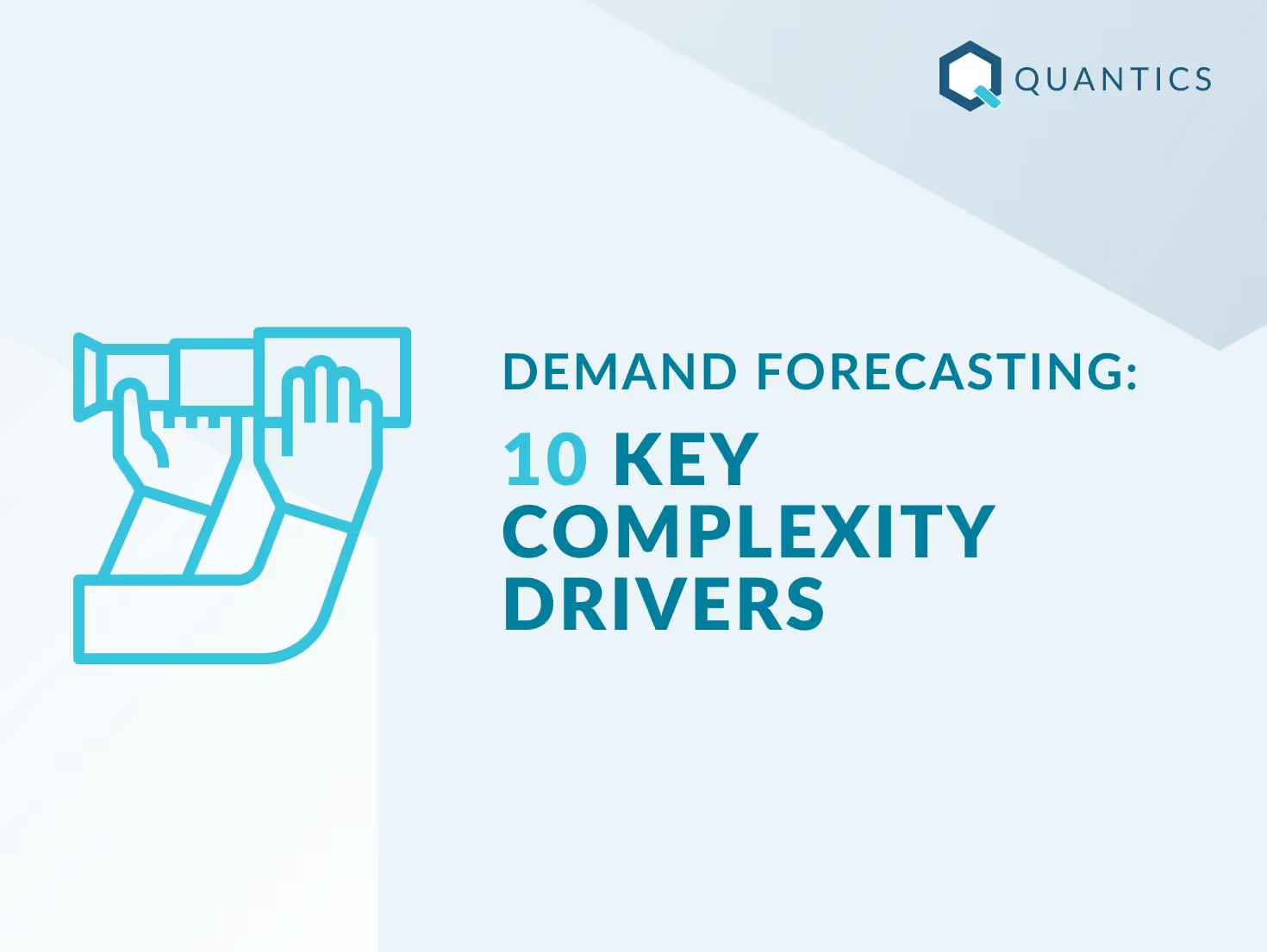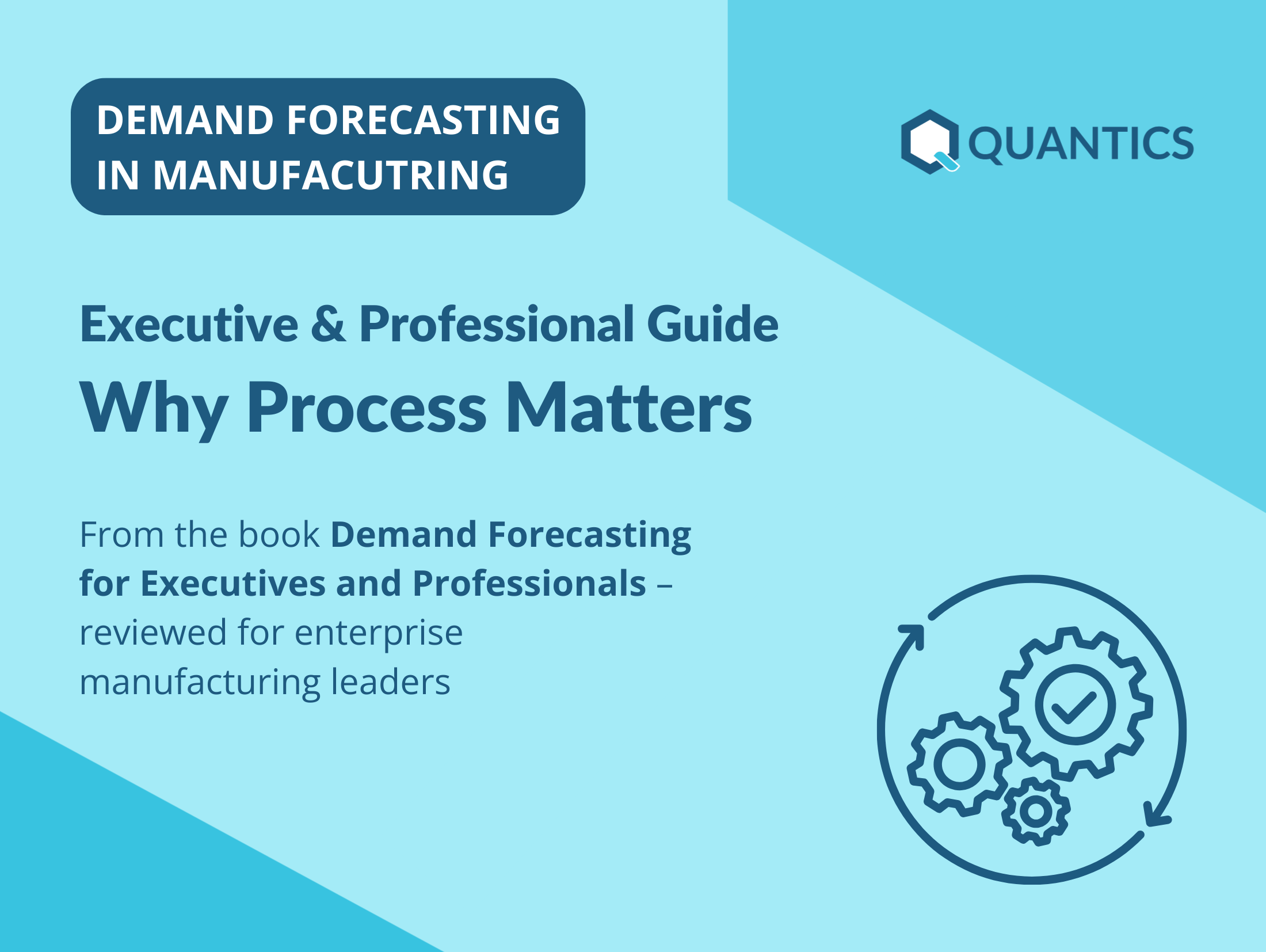Demand forecasting: 10 key complexity drivers
Learn more about the top 10 complexity drivers in demand forecasting and how to tackle them.

Demand forecasting can be complex, especially when consumer behaviour is continuously changing. After this article, you will understand what drives complexity in demand forecasting, which problems arise when doing it manually and what you can do to increase demand forecast accuracy.
Ready? Let's dive in!
What is demand forecasting?
Before we can talk about the difficulties of demand forecasting, it might be helpful to define what it is. Demand forecasting means predicting future sales based on current and past trends. Accurate demand forecasts usually help optimize stock levels, production schedules or inventory management to minimize costs and maximize profits. Many companies use demand forecasts to optimize their marketing and sales activities. In general, it is an integral part of the S&OP (Sales & Operations Planning) process.
What does a typical forecast process look like?
Typically, a demand forecasting process includes the following steps:
- Data Collection: Gather required internal and external data
- Data Analysis: Analyze and understand the collected data
- Forecast Model Composition: Create an appropriate forecast model
- Forecast Creation: Prediction of available observations
- Forecast Accuracy Measurement: Check the forecast accuracy
- Forecast Model Optimization: Adjust and finally validate the forecast model
- Sales Plan Transition: Derive an actionable plan from the results
Now let's take a closer look at the reasons that can drive complexity of this process, especially if done manually.
10 biggest complexity drivers when creating demand forecasts
Volatile consumer behaviour
What people want today might not be what they want tomorrow. Especially when it comes to products and services that are highly volatile. Forecasting those changes is complex and can result in unreliable demand predictions.
External factors
These include but are not limited to weather, competition and events, current macroeconomic conditions, social media buzz around products or services and many others. Forecasting those effects manually and including them in the forecasting process is a huge challenge.
Long lead times
Long-term demand forecasting increases the risk of being wrong since it's much harder to predict what will happen in a year from now than next week. Demand forecasts can become more inaccurate when created for many periods into the future.
Seasonality
Seasonality means there are specific periods along the year when the demand for a product or service is much higher than at other times. Forecasting these changes is essential if a company wants to avoid stock-outs and lost sales. However, predicting the demand for seasonal products is much more complicated than predicting non-seasonal demand.
Number of SKUs (Stock Keeping Unit)
Some companies need to create forecasts for many individual items, services, and product variants. This makes demand forecasting more difficult. Demand forecasting at the SKU level is a very time-consuming and complicated process, which is why it makes sense to rely on machine learning.
Data
Forecasting is a data-driven process that highly depends on the data. However, getting access to good-quality data can be difficult. Often companies need to rely on estimations or assumptions because they don't have enough data points. Forecasting demand based on low-quality data will lead to erroneous results and bad decisions.
Customer development
Predicting the number of future customers is not easy but essential for good long-term results. Anticipating the demand for new customers is much more complicated than forecasting the demand from existing ones.
Scenario analysis
Forecasting demand for different scenarios is often challenging, especially when historical data isn't available. Forecasters usually need to consider different scenarios (e.g., best case scenario, worst case scenario) or what if situations (e.g., what happens if the demand for our product increases by 50%).
Multi-channel complexity
Planning different channels is complicated and becomes even more complex when companies have multiple warehouses or production locations. However, forecasting inventory and production quantities is essential for the most critical supply chain decisions.
Human factor
The final reason why demand forecasting can be difficult is that it's often hard to get everyone on board. Demand planning is not an exact science. There will always be some uncertainty associated with it. This can make it difficult to convince people to use forecasts as a decision-making tool.
Despite all these difficulties, predicting demand is essential for every business. It allows companies to plan their production and inventory, create accurate financial predictions, identify the right timing for marketing campaigns and much more.
What are the downsides if demand forecasting is done manually?
If done manually, demand forecasting is a repetitive task that takes up much of the employees' time. If a company creates plans based on gut feeling or excel, they are likely wrong!
Data complexity
Demand forecasts often lack sufficient historical sales data for analysis especially when it comes to newer products. Those often don't offer enough historical sales data. Therefore forecasting new products is complex and causes problems like e.g. poor inventory management, which leads to higher inventory costs. Manual forecasting of new products is a bad idea with an increased risk of being inaccurate and experiencing lower profit margins due to sell-offs.
Human mistakes
Another issue that may arise when producing forecasts is the human factor. Forecasts are usually generated by people rather than machines, which might be error-prone. As any business can expect to have forecast errors, it's critical to utilize sophisticated analytics techniques to reduce them.
Combining quantitative methods like statistical methods with qualitative methods is always a good idea and usually leads to proper demand forecasting. But be careful. Sales often tend to follow aggressive growth plans that can lead to overstocks which is the opposite of what companies want!
Lack of adaptivity
A significant challenge of manual demand forecasting is the lack of flexibility which is crucial as companies need to adapt quickly. Manually created forecasts cannot be made on the go and are often inaccurate after only a few weeks or months once additional real-time data is involved. Many planners often struggle to include this data in their forecasts because it is too time-consuming to change manually.
Bad integration
Manual demand forecasting has several limitations, including a lack of integration into other systems and software solutions. Creating forecasts in Excel requires the data to be rekeyed or shared using Excel for further analysis. This is in most cases a time-consuming and error-prone task.
Different needs
Forecasting is a complex endeavour that usually involves several departments. Each department has different demands. The sales team wants demand forecasts for a particular sales channel or customer and finance requires accurate predictions to produce a budget. Forecasters, therefore, have to create different versions of their predicitons, which takes a lot of time if done manually.
What are the best ways to create accurate demand forecasts?
Use quantitative forecasting techniques:
Past trends and patterns are essential to quantitative forecasting techniques. The main advantages of this sort of forecasting are its accuracy, reliability and adaptability. However, quantitative forecasting might be difficult to apply if you don't have enough historical data or the wrong personnel in-house to develop appropriate forecast models.
Get reliable forecasting software:
Forecasting through statistical methods can be challenging, which is why forecasting software should be used. Forecasting software like Quantics can help you to easily and quickly create statistically sound forecasts by incorporating all the necessary data, including seasonality and trend analysis, into one platform. Furthermore, it makes it easier to spot patterns in your data and use this information for future predictions.
Train your employees:
At the end of the day, demand forecasting is a process that needs to be done by people. Forecasting experts need to understand which methods are useful in order to create accurate forecasts. Training can help your team to become more knowledgeable about different forecasting methods and understand what needs to be done to improve results.
Bring different departments to the process:
Forecasting is a collaborative process and should involve the right people to get accurate results. Including critical departments in the forecasting process will help to ensure that everyone has a clear understanding of what is forecasted and why. This will also make it easier for departments to use forecasts for their own needs.
Forecasting software can help to make this process more efficient by providing different views of the provided data. In this way, each department gets what they need without being overwhelmed with information that doesn't relate directly to their area of responsibility.
Use historical data to your advantage:
Forecasting is all about predicting demand based on past trends. This means that having access to accurate and up-to-date historical data is essential for a reliable forecast creation.
Forecasting software can make it easy to combine all of your sales data, which may help you stay on top of what's happening in the market. The correct information may assist you in recognizing trends in your sales data and making accurate predictions about future demand.
Select the correct error measurement method:
If you want to know if your results are accurate, it is essential to select a proper error measurement method. The most common ones are mean absolute deviation (MAD) and root mean square error (RMSE). Choosing a good forecast accuracy metric can make a big difference when planning future cash flows, creating sales forecasts or forecasting demand as it allows you to understand how far off your predictions were from reality at any given time.
Align demand forecasts with the company's goals:
Often it is not enough to create a demand forecast. Demand forecasts should be in line with your business needs. Consider all existing data and make adjustments as necessary before using any estimates for planning purposes or investment decisions. For example, if your demand forecast says that there will be an increase in demand next month, but you don't have the resources to meet it right now using this demand estimate as part of a plan would not be wise because it could lead to over-investment or underproduction.
Forecasting software can help to align demand estimates with your company goals by providing an easy-to-use platform that allows you to adjust your forecasts as needed.
Understand demand patterns:
Demand forecasting is not an exact science, which is why a thorough grasp of demand patterns is required. To assist you in determining future demand patterns, you may use demand forecasting software. A good demand planning software will provide you with information on how your demand changes over time, making it easier to derive conclusions.
Consider the impact of external factors:
As you create a demand plan, consider internal factors such as seasonality and external factors like social media trends or macroeconomic data. Forecasting software can help you consider the impact of those factors on your demand to create a more accurate forecast.
Test demand forecasting methods:
Demand planning involves several different forecasting methods. Forecasting software can help you test these methods by comparing them against each other and seeing which one brings the best results for your business needs. This step is an integral part of creating an accurate forecast because it allows companies to select only the most suitable methods for their specific needs.
Final thoughts
Yes, demand forecasting can be difficult, but with the right tools and methods, it doesn't have to. With forecasting software like Quantics you will be able to calculate accurate quantitative estimates in an efficient way.
Furthermore, by training your employees and including different departments in the forecasting process, you can ensure that everyone is on board. And finally, use data to your advantage in order to spot patterns and make better predictions about future demand.
About Quantics
Quantics offers a best-in-class solution for supply chain planning, specifically designed for large manufacturing enterprises. The focus is on innovative, AI-driven forecasting and seamless, collaborative planning that connects teams and makes processes future-proof.
Time for a change.
Start now
Stop battling forecast complexity. With Quantics, you take control
Learn how Quantics contains unique features that can optimally support your manufacturing businesses in unlocking the power of cutting-edge forecasting and supply chain planning.

Frequently Asked Questions
Find answers to common questions about our solutions and how they benefit your operations.






